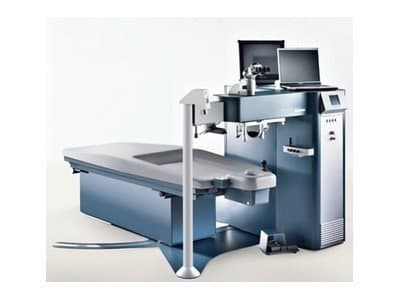LASIK Surgery
What is LASIK?

LASIK is the most common laser eye surgery in the United States today and can be used to treat myopia (nearsightedness), hyperopia (farsightedness), and astigmatism. LASIK is an acronym for “laser-assisted in-situ keratomileuses” and describes the procedure during which a patient’s eye is reshaped using a sophisticated type of laser. This reshaping enables the lens to more accurately focus light onto the surface of the retina, ultimately enabling the anatomy of the eye to function much more naturally and clearing the patient’s vision tremendously. In many cases, the LASIK procedure is pain-free and can be completed in approximately 30 minutes. Results can be seen in as little as one day and are generally long-term.
Who Is a Candidate?
LASIK surgery offers significant benefits to patients, but as is the case for many surgical procedures not everyone is an ideal candidate. First, your eye should be otherwise healthy outside of the issue (myopia, hyperopia, or astigmatism) that is being corrected; that means no infections, injuries, or dry eye. Second, your cornea must be thick enough that the laser has enough tissue to work with when reshaping the surface of the eye. This is something that a physician will determine when you go in for a LASIK consultation. Third, certain anatomical defects like enlarged pupils can rule you out as they can make you more susceptible to side effects of the procedure. Finally, if your vision is too far gone, the procedure may not be for you, as the results of LASIK at higher prescription levels are unpredictable.
Are You a Good Candidate for LASIK?
Take our LASIK Self-Test and find out!
What to Expect
Today, there are a number of different LASIK procedures available to the public. However, you can expect more or less the same thing on the day of your procedure, regardless of which platform your physician uses. Prior to the procedure, you will have a series of consultations with your physician to confirm that this is the best option for you to correct the vision issues you are experiencing.
The surgery itself is typically performed in as little as 30 minutes, even if both eyes are being corrected. During the procedure, your physician will place numbing drops in your eye and insert an instrument to hold your eyelids open. They then cut a small flap into your cornea, allowing them to access the portion of the cornea that is going to be reshaped by the laser. Once in position, they use a pre-programmed laser to remove small amounts of corneal tissue until it reaches the desired shape. Finally, they fold the corneal flap back over, which will generally heal on its own without the need for stitches.
It is likely that you will feel some discomfort and blurred vision immediately following the surgery. Fortunately, these symptoms usually pass quickly. Pain medication and eye drops will be prescribed to help keep you comfortable. The initial follow up appointment with your Physician is to ensure that you are healing properly. Additionally, you will have 3 – 4 appointments over the year after your LASIK to confirm visual stabilization is complete.
What Kind of Technology Is Used For LASIK?

At Center for Sight, we are proud to use some of the most advanced LASIK technology available. One notable technology utilized in our LASIK procedures is the Allegretto Excimer Laser System. The Allegretto laser is a state-of-the-art laser system that provides exceptional precision and accuracy in corneal reshaping. It utilizes a high-speed eye tracker to precisely track the eye’s movements during the procedure.
This tracking feature ensures that the laser remains perfectly aligned with the treatment area, even if there are small involuntary eye movements. By maintaining precise alignment, the Allegretto laser enhances the accuracy of the corneal reshaping process, resulting in optimal visual outcomes.
The Allegretto laser system also incorporates wavefront-optimized technology. This technology takes into account the unique curvature and characteristics of your cornea, allowing for personalized treatment. By optimizing the laser treatment based on the individual eye’s needs, wavefront-optimized technology aims to improve visual quality, reduce the occurrence of glare and halos, and enhance overall night vision. The Allegretto laser also operates at a rapid speed, delivering ultra-fast pulses of laser energy. This swift treatment process minimizes the overall procedure time and enhances overall comfort.
Honoring Our Heroes: Exclusive Military Discount on LASIK
How Much Does LASIK Cost?

The cost of LASIK can vary depending on several factors. At Center for Sight, we understand that the cost of LASIK is an important consideration for patients. We also believe financial considerations should not be an obstacle in obtaining the eyesight you deserve. Our goal is to make leading-edge LASIK affordable for any budget.
For this reason, we offer payment options, like Care Credit, to help make LASIK more affordable and accessible. Many people have medical flex plans that they can use towards their procedure by using pre-tax dollars.
To get detailed information about the cost of LASIK at Center for Sight and the available payment options, contact our billing office or schedule a LASIK consultation. It’s important to keep in mind that the cost of LASIK is an investment in your vision and can provide long-term savings by reducing or eliminating the need for glasses or contact lenses.
Do you want to learn more about LASIK or determine if it may be right for you? Call or text us today at (850) 478-2020 to schedule a LASIK consultation!
Are There Alternatives to LASIK?
If LASIK isn’t the right option for you, your physician may recommend a LASIK alternative, like PRK. PRK offers a different approach that can allow you to achieve clear vision with reduced dependence on glasses and contacts.
During PRK, instead of creating a corneal flap like in LASIK, your surgeon will gently remove the outer layer of the cornea called the epithelium. This step allows them to reshape the underlying corneal tissue using a precise laser. PRK works similarly to LASIK in the way that it reshapes the cornea. However, there is no flap created during PRK. Instead of repositioning the flap after the cornea is reshaped, a protective contact lens is placed on the eye to aid in the healing process. Over time, the epithelium naturally regenerates, and the contact lens is removed.
Both LASIK and PRK are excellent procedures that can allow you to experience greater visual freedom. However, PRK may have some advantages over LASIK, especially if you have thin corneas or other corneal irregularities that make LASIK unsuitable for you. For example, if you participate in contact sports or activities with a higher risk of eye trauma, PRK may be a better choice because there is no corneal flap that could be dislocated or injured. In some cases, PRK may have a slightly longer recovery period compared to LASIK. This is because it takes time for the regenerated epithelium to heal and the cornea to stabilize fully. To determine which procedure may be best for you, visit your eye doctor at Center for Sight.


